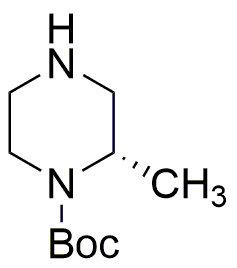(S)-1-(tert-Butoxycarbonyl)-2-methylpiperazine is widely utilized in research focused on:
- Pharmaceutical Development: This compound serves as an important intermediate in the synthesis of various pharmaceuticals, particularly in the creation of piperazine derivatives that exhibit biological activity.
- Drug Formulation: Its properties allow for effective formulation of drugs, enhancing solubility and stability, which is crucial for oral and injectable medications.
- Research in Neuroscience: The compound is used in studies related to neurotransmitter systems, aiding in the development of treatments for neurological disorders.
- Organic Synthesis: It plays a significant role in organic synthesis processes, particularly in the production of complex molecules, making it valuable for chemists in both academic and industrial settings.
- Biochemical Applications: The compound is utilized in various biochemical assays, helping researchers understand enzyme interactions and metabolic pathways.
General Information
Properties
Safety and Regulations
Applications
(S)-1-(tert-Butoxycarbonyl)-2-methylpiperazine is widely utilized in research focused on:
- Pharmaceutical Development: This compound serves as an important intermediate in the synthesis of various pharmaceuticals, particularly in the creation of piperazine derivatives that exhibit biological activity.
- Drug Formulation: Its properties allow for effective formulation of drugs, enhancing solubility and stability, which is crucial for oral and injectable medications.
- Research in Neuroscience: The compound is used in studies related to neurotransmitter systems, aiding in the development of treatments for neurological disorders.
- Organic Synthesis: It plays a significant role in organic synthesis processes, particularly in the production of complex molecules, making it valuable for chemists in both academic and industrial settings.
- Biochemical Applications: The compound is utilized in various biochemical assays, helping researchers understand enzyme interactions and metabolic pathways.
Documents
Safety Data Sheets (SDS)
The SDS provides comprehensive safety information on handling, storage, and disposal of the product.
Product Specification (PS)
The PS provides a comprehensive breakdown of the product’s properties, including chemical composition, physical state, purity, and storage requirements. It also details acceptable quality ranges and the product's intended applications.
Certificates of Analysis (COA)
Search for Certificates of Analysis (COA) by entering the products Lot Number. Lot and Batch Numbers can be found on a product’s label following the words ‘Lot’ or ‘Batch’.
*Catalog Number
*Lot Number
Certificates Of Origin (COO)
This COO confirms the country where the product was manufactured, and also details the materials and components used in it and whether it is derived from natural, synthetic, or other specific sources. This certificate may be required for customs, trade, and regulatory compliance.
*Catalog Number
*Lot Number
Safety Data Sheets (SDS)
The SDS provides comprehensive safety information on handling, storage, and disposal of the product.
DownloadProduct Specification (PS)
The PS provides a comprehensive breakdown of the product’s properties, including chemical composition, physical state, purity, and storage requirements. It also details acceptable quality ranges and the product's intended applications.
DownloadCertificates of Analysis (COA)
Search for Certificates of Analysis (COA) by entering the products Lot Number. Lot and Batch Numbers can be found on a product’s label following the words ‘Lot’ or ‘Batch’.
*Catalog Number
*Lot Number
Certificates Of Origin (COO)
This COO confirms the country where the product was manufactured, and also details the materials and components used in it and whether it is derived from natural, synthetic, or other specific sources. This certificate may be required for customs, trade, and regulatory compliance.


